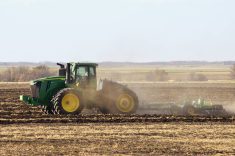Effective grain storage strategies and budgeting in the year to come will be crucial to maximize profitability, says Darren Bond, a farm management specialist with Manitoba Agriculture.
Why it matters: The 2024 crop is in the bin, but farmers can still take steps to widen their profit margin.
Speaking in the final Crop Talk webinar hosted by the province this year, Bond urged farmers to regularly update crop budgets throughout the season and understand the cost of storing grain. The market situation is ever-changing, and financial planning is required to navigate market volatility and rising production costs.
Read Also

Manitoba boosts stake in cereals centre to $23.5 million
Premier Wab Kinew said the additional project funds will help ‘Trump-proof’ the provincial economy.
“It’s not something that we go and we create projections — say, like, for next year, 20 projections — and then we put them to the side of the desk and never come back to them.”
That means cracking open the spreadsheets or other planning tools when new data like grain sales and yield figures come out.
Bond also urged producers to think in cost per bushel, which he said is more effective for making marketing decisions than costs per acre, especially as producers gain more clarity on how much grain reached the bin.
There are digital tools available to help farmers keep on top of data, he added. He highlighted one such tool, an Excel-based calculator called CropPlan, available through Manitoba Agriculture’s website. The calculator allows producers to input cost data, including fixed costs like land and equipment.
“One of the questions I always get is, “well, how do I figure out fixed costs, like the cost for land and equipment?” Bond said. “This allows us to put in our actual loan payments, and it will pro-rate it out into a per acre amount.”
The tool is free, but there are many other planning tools on the market. Or producers might prefer their own spreadsheets or pencil on paper. Type of system doesn’t matter, Bond said. The important thing is using it to keep track of production costs.
The province’s next cost of production estimates are expected in December.
Storage
Bond urged farmers to take a close look at grain storage and marketing strategies. The grain is in the bin, but storage costs money.
“There’s a few things when it comes for the cost to carry: interest, storage, insurance — mainly interest and storage in Manitoba,” Bond said.
Farmers can assess storage costs by calculating interest costs based on current operating loan rates and value of the grain.
Patience remains a crucial virtue in navigating the grain market, Bond said.
“We get hammered with bad news and funds are shorting the market, and then all of a sudden things turn around, and we have a rally, and then the rally is over, and we get back to where we were before.”
















